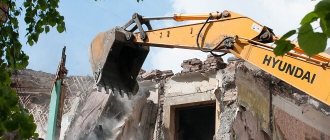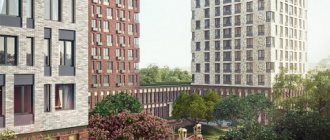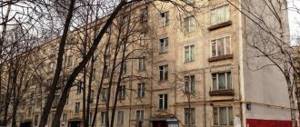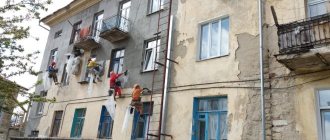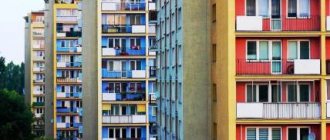Home / Real estate / Renovation / Renovation in Moscow
Back
Published: 06/11/2018
Reading time: 4 min
0
797
The beginning of the renovation program in Moscow aroused the desire among residents of many regions of the country to move from their Khrushchev-era apartment buildings to new housing. The Moscow region was no exception. The regional government is studying the experience of the capital and is thinking about developing its own program.
- Plan for the demolition of five-story buildings in the Moscow Region
- Where can I get information?
Main stages of the program
The idea of demolishing outdated five-story buildings is far from new and has been working in Moscow for more than 20 years. But not all regional units completed the planned change of housing. On the day of publication of the article, according to the first wave of the program, 75 five-story buildings remained undismantled. In February of this year, on behalf of the president, the city hall authorities developed a renovation plan, although specific calendar terms have not yet been announced. If all certain conditions and prerequisites are met, the wave of demolition of objects of the demolished and non-demolishable categories will begin in 2017-18 throughout the city, and not just in individual areas. The work will involve 25 million residential square meters with a total number of residents of 1.7 million.
Demolition of Khrushchev buildings
According to the program for clearing the capital of obsolete buildings, the Moscow Construction Department has prepared a schedule for the demolition of five-story buildings by district and district of the city. First of all, this schedule involves the demolition of about 65 five-story buildings, and eleven old residential buildings, according to Interfax, have currently already been dismantled. Almost all of the destroyed houses were dismantled at government expense, the rest under investment agreements.
The presented schedule for the demolition of five-story buildings in Moscow and the address list of houses serves as a specific report to the public and residents regarding the progress of the project. Upon completion of the first period, the second stage of the new program will come into effect with the dismantling of eight thousand five-story buildings with the resettlement of 1.6 million owners of the demolished fund with a general implementation period of about 20-25 years. The official lists include five-story buildings recommended for dismantling, which best meet the stated requirements for demolition. The opinion of residents after the survey and voting will be taken into account.
Unsuitable for major repairs - why did Putin order the demolition of all five-story buildings in Moscow?
At a meeting with Moscow Mayor Sergei Sobyanin on February 21, 2021, the President of the Russian Federation ordered the demolition of outdated buildings and the construction of new housing in their place.
This decision was made in connection with economic calculations carried out on the feasibility of major repairs of such emergency housing, which turned out to be unprofitable. The President said that his order is based on the desire of citizens to receive new and comfortable housing. The main question in this difficult matter was the budgetary capacity of the capital: will the government be able to cope with the financial burden, and will there be investors? According to the Moscow mayor, the capital will cope with the entrusted responsibility for the demolition of Khrushchev-era buildings and the subsequent construction of new housing, and no financial obstacles are foreseen for this.
At a meeting of the Public Chamber, they clearly explained why it is inappropriate to carry out major renovations of old five-story buildings. They gave a simple example that in five-story buildings all communications are hidden inside the walls, and they will need to be broken when carrying out major repairs. During such work, people will have to be resettled, which is a big problem.
In general, most five-story buildings are not suitable for major repairs at all. These buildings were built over 60 years ago and were designed to last 25-30 years. Today, 1.6 million people live in houses that are subject to demolition.
Nuances of renovation
The developed renovation plan is aimed at a radical solution to the issue and does not for the most part provide for any reconstruction or repair of dilapidated housing stock. All series of houses allocated for renovation will be completely demolished, and the owners will first receive modern, comfortable housing, mainly according to the footage of their apartments.
Investors-developers and the capital's mayor's office will finance the liquidation of old buildings and the resettlement of residents of demolished houses. According to the program for the demolition of these houses, new areas with the necessary infrastructure, metro stations and other transport links are being prepared today. Resettlement work for 2021 is mainly planned by the department for the autumn-spring period:
• for the 2nd quarter of this year - 28 houses; • in the third quarter of 2017 - 7 houses; • in the fourth quarter of 2021 - 29 houses.
All information on the five-story buildings planned for dismantling for the current year can be found on the website and interactive map of the construction department. The city authorities plan to completely modernize the residential market. During the resettlement of the planned eight thousand demolished five-story buildings, 30,000,000 square meters of comfortable, modern housing will be required, and 300 billion rubles will be allocated from the city budget for the first stage of resettlement. The presented schedule for the demolition of five-story buildings in Moscow according to the last stage of renovation includes, along with the classic block Khrushchev buildings, five-story buildings of a later commissioning that do not yet have emergency status.
“Moscow without Khrushchev”: how residents of five-story buildings will be resettled
The demolition of Khrushchev buildings, announced by the Moscow authorities, could begin this year. However, the legal framework for this program is still in its infancy - a bill that will regulate the demolition of five-story buildings in the capital was submitted to the State Duma several weeks ago. Pravo.ru tells how the demolition of five-story buildings will be regulated and what apartments the residents of the demolished buildings will receive in return. The publication's experts said what exactly those owners of Khrushchev apartments who do not agree with moving to new houses will be able to challenge in court. A new round of the program for the demolition of Moscow five-story buildings was given by the meeting of Sergei Sobyanin with Vladimir Putin, which took place in February of this year (see “Vladimir Putin allowed Sobyanin to demolish dilapidated Moscow five-story buildings”). The capital’s mayor then explained to the president that there was no point in repairing worn-out houses, but it would be easier to “renovate” the building areas. Putin approved this idea and instructed the Ministry of Construction, together with the Moscow government, to develop a special law that will increase the efficiency of the program for the demolition of Khrushchev buildings. The necessary bill was developed in record time and already on March 10, 2021, its authors, including United Russia members Gennady Onishchenko and Anatoly Vyborny , as well as the chairman of the Federation Council Committee on Science, Education and Culture Zinaida Dragunkina , submitted the initiative for consideration to the State Duma. The proposed amendments introduce changes to the law “On the status of the capital of the Russian Federation” and certain legislative acts “in terms of establishing the features of renovation of the housing stock in the capital of the Russian Federation - the federal city of Moscow.”
Muscovites will receive apartments 35% more expensive as a result of the five-story renovation program.
Source: Explanatory note to the bill regulating the demolition of Khrushchev buildings
What is being demolished and what kind of housing will be given in return: high-rise buildings near highways instead of Khrushchev-era buildings
The main essence of the parliamentary proposal is to demolish all the old Moscow five-story buildings. The renovation zone also includes other houses that are “similar in their design characteristics.” Agreements will be concluded with the owners and tenants of such housing, according to which the Moscow authorities will be obliged to provide “equivalent” apartments within the boundaries of the same or neighboring district in exchange for the “demolished” apartments. There is an exception for residents of the Central, Zelenogradsky, Troitsky and Novomoskovsky administrative districts: they will receive new apartments within the district. “Equivalent” means comfortable housing, the total and living area of which corresponds to the previous apartment, down to the number of rooms. However, the bill does not take into account the level of residential and transport infrastructure that the residents of Khrushchev had. The owner of an apartment within walking distance of the metro and parks can get new housing near the highway within an hour's walk to the nearest subway station. Marina Kostina, lawyer at Yakovlev and Partners Law Firm, explains that in the current version of the law, the owner will not be able to refuse new housing if he is not satisfied with the floor or layout of the apartment. The bill also does not take into account the number of people living in the demolished “Khrushchev”: a family of six people huddled in a privatized “one-room apartment” will receive an apartment of the same size in the new building. Another negative point is that although owners and tenants of housing included in the program will be exempt from paying contributions for major repairs, no one will compensate them for the costs of moving and repairs in new houses.
The first to be demolished will be the five-story buildings of the I–510 and I–515 series, which were built in the late 1950s and early 1960s. According to the authors of the idea, they are so dilapidated that it is impossible to even install water meters in these houses, there are no elevators or garbage chutes, and the roofs are leaking. Most of these “Khrushchevka” buildings are located in the Donskoy, Meshchansky, Presnensky districts, as well as in Tekstilshchiki, Zamoskvorechye and Konkovo. The Moscow authorities promise to compile an exact list of houses by the fall of 2021. “Capital construction projects that are not housing construction projects” will also be demolished. That is, shops and garages are also at risk. To implement the new program, they plan to create a “Fund for Promoting the Renovation of Housing Stock in the City of Moscow.” Such an organization will be given the authority to act as a developer.
In return, residents are promised to be provided with apartments in new multi-storey buildings, which are going to be built near highways, so as not to spend extra money on additional transport infrastructure. The system for commissioning new housing for “displaced people” will also be simplified. Some preparatory construction work will be allowed to be carried out even before the authorities issue construction permits. To speed up the connection of constructed houses to the infrastructure, a public easement will be introduced on all private plots of the adjacent territories. The explanatory note to the project states that preparing the territory for development will take no more than three and a half years, and construction itself will take no more than two years. Sergei Egorov, lawyer, managing partner of AB EMPP, is confused in this regard by the fact that the renovation plan may not comply with land use and development rules: “The bill allows for deviations from technical regulations and rules, including sanitary-epidemiological and fire requirements.” That is, according to the law, it is permissible to build a house for “displaced people” along a noisy highway in violation of sanitary and other requirements.
Resolution of the Plenum of the Supreme Court dated July 2, 2009 No. 14 “On some issues that arose in judicial practice when applying the Housing Code of the Russian Federation” explains in detail in paragraph 37 what kind of housing the state should provide to residents of demolished houses. The general criteria are as follows:
– it must be well-equipped in relation to the conditions of the relevant locality,
– equivalent in total area to the previously occupied residential premises,
– meet established sanitary requirements and be located within the boundaries of a given locality.
How they will demolish it: “If someone doesn’t like something, then let’s go out”
The city authorities have already begun to prepare the ground for the demolition of houses, having begun to survey the territory on which the Khrushchev buildings stand. But for some reason the townspeople were not warned about this. One of the residents of such a block in the Presnensky district, Yulia Sergeeva*, spoke about how this happens in practice. According to her, she learned about the development of a land survey plan by chance, after overhearing a conversation between two men on the street. After that, she told her neighbors about the overheard conversation. Residents then turned to the administration of the Presnensky district, where they were confirmed: in the council building they are now presenting a plan for determining the boundaries of the territory.
Public hearings to discuss the mentioned project should take place on April 6, 2021, but no one notified the owners of the Khrushchev apartments about this. For now, citizens come to the district administration to write their negative reviews of the land survey plan. According to Sergeeva, Deputy Head of the Presnensky District Administration for Construction and Reconstruction, Denis Potapkin, residents are not satisfied with such opinions. At one of the meetings, an official said: “If someone doesn’t like something, then let’s go out.” Sergeeva says that they are concerned about this attitude on the part of the authorities: “Will they evict us too, having warned us two months before the forced move, and will those who disagree be asked to come out for a showdown?”
At the same time, the mayor promises that they will resettle “only those neighborhoods where the majority of citizens say: “Yes, we want, yes, this is necessary,” and the electronic services “Active Citizen” and “My Documents” will come to their aid. That is, according to Sobyanin’s plan, the decision to decommission houses will be made by city authorities, based on the opinion of the majority of citizens. If the demolished block contains not only “Khrushchev” buildings, but also other high-rise buildings, then all residents will be surveyed via Internet services about whether they want to be relocated or not.
When the authorities receive consent from the majority of citizens, the latter will enter into exchange agreements with the mayor's office, which indicate the area, number of rooms and all technical characteristics of the old and new apartments. The owner or tenant of housing in the house being resettled will be given only two months to sign agreements with the city authorities. During the specified time, the authorities are guaranteed to offer the owner of the Khrushchev apartment only one option for a new apartment. A citizen will have a choice only if his neighbors refuse other housing.
Those who fail to reach an agreement within the specified time will be evicted through the courts. The bill emphasizes that the court decision is subject to “immediate execution and can be challenged only in terms of the equivalence of the residential premises provided.” Appealing this act to higher authorities will not become an obstacle to forced eviction and compulsion to conclude an agreement (see “Residents of the capital’s five-story buildings for demolition will be evicted through the court without the possibility of appeal”). That is, the exact date of demolition will be determined after the decisions of the courts of first instance on the forced eviction of those who are against come into force.
In Moscow, about 25 million square meters have to be resettled. m
About 1.6 million people live in this territory
The cost of renovation is four annual budgets of the capital, approximately 6 trillion rubles.
Source: Explanatory note to the bill regulating the demolition of Khrushchev buildings
You can trace the prospects for such disputes now. For example, on March 28, 2021, the Dorogomilovsky District Court began hearing the case of the forced eviction of the Migunovs from the local “Khrushchev” building. Lawyer Elena Chuevskaya told us about this dispute : “A family of six people asked the city authorities to provide them with housing in the same area so that they would remain attached to their clinic, where they have been seen for a long time. In addition, the Migunovs wanted to get at least two apartments, so as not to be crowded with six people in one living space again.” However, the Moscow City Property Department refused both requests and is now trying to forcibly evict them (case No. 02-1399/2017). The next meeting on this dispute will take place on April 10, 2021.
How to improve your living conditions
Some owners of Khrushchev apartments are probably hoping to improve their living conditions thanks to the discussed resettlement program. However, not all so simple. As a rule, there is no such opportunity and the move occurs in the general order, and the place in the queue for improvement is reserved for the citizens who are waiting, says Ekaterina Kutuzova, lawyer at MCA Knyazev and Partners .
Although the judicial practice on this issue is clear, the lawyer adds: “When a citizen is in line to increase his living space, then upon resettlement he receives a new apartment taking into account the missing square footage in the same city” (case No. 33-4688/2016).
Thus, with the demolition of Khrushchev apartment buildings in Moscow, those who wish will have the opportunity to improve their conditions, but there is a high probability that this will require agreeing to new apartments in more remote areas. If citizens do not want to move to the outskirts of the center in order to expand their living space, then they will have to be content with equivalent housing in the same district.
Those who have never been in line for improvement, but also want to move to better apartments, will be able to take advantage of a preferential mortgage, said Deputy Mayor of Moscow, Marat Khusnullin . According to him, it is too early to talk about the timing of the implementation of the mentioned program: “First, we need to determine the number of property owners in the demolished five-story buildings who want to move. Then, for these people, it is necessary to calculate the number of apartments, location and timing of their construction. And only after this will the terms of the preferential mortgage become clear.”
How to help “immigrants” or why there is no chance of legal protection: opinions of experts “Pravo.ru”
More and more often, legal regulation in the country is not based on the principle of constructing a system of regulations, but on the principle of exceptions to the general rule, says Dmitry Nekrestyanov, partner, head of the real estate and investment practice at Kachkin and Partners . For example, the expert considers it unreasonable to issue an urban development plan for an unformed land plot or transfer all regulation to the level of Moscow legislation, although this is exactly what the bill proposes. Nekrestyanov’s financial and economic justification for the law only raises eyebrows: “The document states that its adoption will not entail budget expenses.” From a legal point of view, the bill raises many questions for Sergei Egorov, lawyer, managing partner of AB EMPP . According to him, a significant part of such a document should be occupied by a section on the rights and guarantees of resettled persons, but it is completely absent. The future law also limits the right of citizens to judicial protection, says the managing partner of AB EMPP: “It will only be possible to challenge the equivalence of the housing provided.” That is, if you are dissatisfied with the new apartment, it makes sense to go to court only to “try” to get an apartment closer to the metro.
FBK Legal partner Alexander Ermolenko agrees with his colleagues and believes that the very idea of demolishing five-story buildings shows the state’s attitude towards private property: “The official sincerely does not understand why it is impossible to take away a citizen’s apartment when for the vast majority of people this is the only expensive property.” The expert also notes the executive’s disdain for the judiciary, which can be seen in the bill under discussion: “The Moscow government does not doubt for a second that all the cases against citizens will be won, although there will certainly be many of them given such a scale of “expropriation.” The lawyer also confirms the lack of effective protection for dissenting citizens: “Judging by the design of the law itself, as intended by the authors, the courts will simply complete the process of confiscation of property.”
Thus, the effective right to judicial protection for residents of demolished houses is practically excluded. Arguments that the land for resettled housing has been privatized will not help either. The only thing that the owners of Khrushchev apartments can count on in court is to achieve guaranteed equivalent housing if the city authorities try to issue a smaller apartment. FBK Legal partner Alexander Ermolenko does not rule out that there will be dissenters who will go to the Constitutional Court, challenging the legality of such a forced relocation procedure. And the Constitutional Court will have its last word in the judicial protection of the rights of residents of five-story buildings.
has the opposite opinion . She believes that the initiative to demolish Khrushchev buildings from a legal point of view complies with the legislation of the Russian Federation, provided that the housing rights of citizens are respected. The expert also notes important innovations in the bill introduced to the Duma: “The document provides for the provision of equivalent housing to residents of Khrushchev-era buildings, although existing norms give the state only such a right, and not an obligation.” Tatyana Petrykina, a lawyer in the real estate practice at Dentons, is especially positive about how quickly the initiative to renovate the housing stock was put into legal form. At the same time, the expert draws attention to another shortcoming of the bill submitted to the State Duma: the document contains a large number of blanket (editor's note - reference) norms. Petrykina states that government bodies are vested with a wide range of powers. Owners of apartments in five-story buildings will definitely receive housing in new buildings, but Muscovites will not be able to challenge the quality of such apartments and the level of surrounding infrastructure in court, the lawyer summarizes.
How Moscow Khrushchev buildings were demolished in recent years: historical background
Back in 1999, the Moscow government adopted a program for the reconstruction of “five-story building areas of the first period of industrial housing construction.” This list includes the so-called “Khrushchev buildings” - five-story panel buildings of the K-7, II-32, II-35, 1MG-300, 1605-AM series. They were built between 1959 and 1962. In total, we were talking about 1,722 houses with an area of 6.3 million square meters. meters.
But the demolition of such housing began to be actively carried out only in 2006. In order to guarantee Muscovites the right to new housing instead of “Khrushchev” buildings, in the same year the city authorities adopted the Law “On ensuring the housing rights of citizens when relocating and vacating residential premises in the city of Moscow.” The main thesis of the mentioned act is that new apartments should be of equal value for residents of Khrushchev-era apartments.
However, the demolition of dilapidated housing proceeded slowly and the completion date of the city program was constantly postponed. Sergei Sobyanin, after taking office as mayor of Moscow in 2011, announced his “Housing” initiative, which provided for the demolition of the last five-story buildings by the end of 2014. But even this has not yet ended.
* – names and surnames have been changed by the editors
- Judgment, Advocacy, Courts and judges
- Town Planning Code, Housing Code of the Russian Federation
- Sergei Sobyanin
- Moscow
Demolition schedule until 2021
In accordance with the points of the housing program of the Russian Federation, the complete elimination of outdated Khrushchev-era buildings will be carried out by the end of 2021. The measures are aimed at resettling residents from demolished series of houses that are not subject to reconstruction or repair. Residential buildings of a different class, included in the second metro ring, will be operated after reconstruction and modernization through budget finance and investors. But despite the opinion of some residents about the good condition of their houses, the city authorities are determined to remove all outdated five-story buildings from the capital.
Demolition schedule for five-story buildings
The renovation program involves not only the direct demolition of houses, but also a more important and expensive part of the project for relocating residents. The demolition and resettlement process is expected to be carried out using a wave type of development, which includes:
• construction or acquisition of new residential space; • relocation of residents; • demolition of a dilapidated house; • instead of a demolished building, the construction of a new one.
Along with providing living space, the necessary infrastructure will be organized: schools, kindergartens, hospitals, parking lots, communications, etc. The use of the wave development method makes it possible to satisfy the interests of both resettled residents and direct developers. Thanks to this method of development, the requirements of the residents are satisfied, since they remain in their usual place of residence.
Current address list for 2021
- 2nd Khutorskaya st., 6-14, building 2
- Festivalnaya st., 17
- Festivalnaya st., 21
- Festivalnaya st., 15, building 2
- Festivalnaya st., 15, building 4
- Annenskaya st., 6
- Bolshaya Maryinskaya st., 11, building 1
- Bolshaya Maryinskaya st., 11, building 2
- Godovikova st., 10, building 1
- Godovikova st., 10, building 2
- Dezhneva pr-d, 12, building 1
- Dezhneva pr-d, 22, building 2
- Dezhneva pr-d, 8
- Dezhneva pr-d, 26, building 2
- Dezhneva pr-d, 26, building 3
- Dobrolyubova st., 17
- Milashenkova st., 7, bldg. 3
- Polyarnaya st., 3, bldg. 2
- Snezhnaya st., 19, building 1
- Fonvizina st., 11
- Sheremetyevskaya st., 31, building 2
- Yablochkova st., 22, bldg. 1
- Yablochkova st., 22, bldg. 2
- Yablochkova st., 22, bldg. 3
- Yablochkova st., 18, bldg. 3
- Yablochkova st., 18, bldg. 4
- Yablochkova st., 20, bldg. 2
- Sheremetyevskaya st., 31, building 1
- Dezhneva Ave., 22, building 1
- Dezhneva Ave., 26, building 1
- Molodtsova st., 17, building 1
- Molodtsova st., 25, building 1
- Molodtsova st., 33, bldg. 1
- Polyarnaya st., 5, building 2
- Yasny Ave., 16, bldg. 2
- Izmailovsky Avenue, 63
- Kirpichnaya st., 49
- Konstantin Fedina st., no. 15
- Konstantin Fedina st., no. 17
- Plyushcheva st., 15, bldg. 3
- Dm. Ulyanova st., 27-12, building 1
- Dm. Ulyanova st., 27-12, building 2
- Dm. Ulyanova st., 27-12, building 3
- Dm. Ulyanova st., 27-12, building 4
- Obrucheva st., 5, building 2
- Obrucheva st., 7
- Obrucheva st., no. 9
- Profsoyuznaya st., 96, building 1
- Profsoyuznaya st., 96, building 2
- Profsoyuznaya st., 96, building 3
- Profsoyuznaya st., 98, building 2
- Profsoyuznaya st., 98, building 6
- Profsoyuznaya st., 98, building 7
- Profsoyuznaya st., 98, building 8
- Chernomorsky Blvd., 22, building 2
- Dm. Ulyanova st., 45, building 1
- Dm. Ulyanova st., 47, building 1
- Profsoyuznaya st., 98, building 3
- Profsoyuznaya st., 98, building 4
- Sevastopolsky Prospekt, 22
- Shvernika st., 6, building 2
- Ak. Pavlova st., 28
- Ak. Pavlova st., 30
- Ak. Pavlova st., 32
- Ak. Pavlova st., 34
- Ak. Pavlova st., 36
- Ak. Pavlova st., 38
- Ak. Pavlova st., 40
- Ak. Pavlova st., 54
- Ak. Pavlova st., 56, building 1
- Yartsevskaya st., 27, building 5
- Yartsevskaya st., 31, building 1
- Yartsevskaya st., 31, building 2
- Yartsevskaya st., 31, building 3
- Yartsevskaya st., 31, building 4
- Yartsevskaya st., 31, building 5
- Yartsevskaya st., 31, room 6
- Leninsky Prospekt, 110, building 3
- Leninsky Prospekt, 110, building 4
- Leninsky Prospekt, 134
- Leninsky Prospekt, 136
- Leninsky Prospekt, 138
- Vernadsky Prospekt, 64
- Vernadsky Prospekt, 66
- Vernadsky Prospekt, 68
- Vernadsky Prospekt, 70
- Vernadsky Prospekt, 72
- Vernadsky Ave., 74-50
- Koshtoyantsa st., no. 19
- Koshtoyantsa st., no. 27
- Koshtoyantsa st., 37
- Koshtoyantsa st., no.9
- Lobachevskogo st., 84
- Kastanaevskaya st., 55
- Kastanaevskaya st., 57, bldg. 1
- Kastanaevskaya st., 61, bldg. 1
- Kastanaevskaya st., 61, bldg. 2
- Kastanaevskaya st., 63, bldg. 1
- Malaya Filevskaya st., 16
- Malaya Filevskaya st., 22
- Malaya Filevskaya st., 24, bldg. 1
- Malaya Filevskaya st., 24, bldg. 2
- Malaya Filevskaya st., 24, bldg. 3
- Davydkovskaya st., 10, building 1
- Davydkovskaya st., 10, building 2
- Davydkovskaya st., 10, building 3
- Davydkovskaya st., 10, building 4
- Davydkovskaya st., 12, building 1
- Davydkovskaya st., 12, building 2
- Davydkovskaya st., 12, building 4
- Davydkovskaya st., 12, building 5
- Davydkovskaya st., 2, building 7
- Davydkovskaya st., 4, building 1
- Davydkovskaya st., 4, building 2
- Davydkovskaya st., 4, building 3
- Kremenchugskaya st., 5, building 1
- Slavyansky Blvd., 5, building 2
- Slavyansky Blvd., 9, building 3
- Slavyansky Blvd., 9, building 4
- M. Zhukova Ave., 35, building 2
- M. Zhukova Ave., 51, building 3
- M. Zhukova Ave., 51, building 4
- People's Militia st., 13, building 3
- People's Militia st., 13, building 4
- People's Militia st., 11, building 3
- People's Militia st., 11, building 4
- Turistskaya st., 14, building 1
- Yana Rainisa Boulevard, 2, bldg. 2
- Yana Rainisa Boulevard, 2, bldg. 3
Important! Additions and changes are constantly being made to the list. It is recommended to clarify the presence of a particular house there by making an official request to city services.
If you find an error, please select a piece of text and press Ctrl+Enter.
Didn't find the answer to your question? Find out how to solve exactly your problem - fill out the form below or call right now: +7 (ext. 697) (Moscow) +7 (ext. 281) (St. Petersburg) +8 (ext. 198) (Russia) It's fast and free!
Houses to be demolished by county
According to new lists for the dismantling of dilapidated five-story buildings by 2025, more than 500 blocks throughout Moscow may be included in the renovation program. Almost all districts and districts of the capital are on the demolition lists. Since the beginning of May, lists of houses subject to renovation until 2025 have been openly published in the media and on the Internet, as well as schedules for dismantling old houses by district, namely:
• in the Eastern Administrative District of Moscow includes 1064 houses; • in the South-Eastern Administrative District includes 673 houses; • in North-Eastern Administrative District includes 524 houses; • in the Northern Administrative District includes 426 houses; • in the South-Western Administrative District includes 460 houses; • in the Southern Administrative District of Moscow includes 363 houses.
In the Central District, 77 houses are on the demolition schedule. Top priority lists include dilapidated buildings with residents collectively requesting relocation. According to the developed schedule for the demolition of five-story buildings in Moscow and the list for demolition in the South-Eastern Administrative District, today there is an active search for starting capacities for the construction of the first objects during the wave of resettlement. According to the head of the prefecture, launch sites are also being prepared in all districts of the capital. According to the schedule for the demolition of five-story buildings in the closed joint-stock company of Moscow, as well as other districts, today there is an active discussion and voting of residents regarding the proposed development sites. The possibility of using the territories of former industrial zones is being considered, divided into districts, and proposals from district authorities and the Moscow Committee for Architecture are discussed. The capital authorities, taking into account the needs of different categories of resettled residents, are carefully considering the possibility of issuing preferential mortgages for those wishing to increase their living space during renovation.
The order of demolition of houses under the renovation program
In what time frame will the demolition of the unbearable series of five-story buildings be carried out?
The exact resettlement schedule is updated in the process of approving new launch sites and finalizing projects taking into account the opinions of residents. The Moscow government promises to adopt the final version of the renovation program no later than June 30, 2021.
Muscovites receive notification 2 months before relocation. It is handed over personally or dropped into a mailbox. It states:
- address (owners can choose from ready-made objects);
- footage of the new home;
- number of rooms;
- duration and procedure of inspection;
- a place where you can get the keys.
Next, you need to inspect the property. This is given 5 days from the date of receipt of the notification. If the proposed option suits the migrant, consent to the move should be issued.
To draw up an exchange agreement, you need to provide a certificate of ownership or an extract from the Unified State Register of Real Estate and passports of all those registered.
The Renovation Fund provides assistance with relocation. To receive compensation for transportation costs, you must submit an application to the Resettlement Information Center. Those in need can ask for assistance in transporting and assembling furniture.
On the mos.ru website, in the “Services” section, instructions are given: how to detach from a clinic and attach to a new one, transfer a child to kindergarten or school, enroll in first grade at a new address. Transfers to another clinic, kindergarten, or school are carried out at the request of the migrant.
The latest information on the program, addresses of demolished houses and launch sites can also be found on the official website of the Moscow Mayor mos.ru.
Signs of demolished houses
Five-story houses, made of standardized panel elements and built during the time of Khrushchev, were popularly called Khrushchev buildings after the prototype of their creator. Their main purpose and the very purpose of their creation was to resettle families from communal apartments, dormitories and premises unsuitable for habitation in the shortest possible time and with minimal expenditure of money and time. Initially, the service life of the houses being built was expected to be short due to insufficient technological strength, no more than 25-30 years, with subsequent relocation to more comfortable housing. But temporary, economical versions of houses, planned for demolition back in the last century, still decorate our cities. If in the capital the issue of resettlement is somehow being resolved, then in other regions of the country it is not even raised. The main characteristics of block houses with a temporary residence term include:
• walls with minimal heat and sound insulation; • the total area of one-room apartments is 30 sq. m. m, two-room apartments - 46, three-room apartments - 60; • first floors without balcony; • lack of a garbage chute or elevator; • ceilings 2-2.5 m; • adjacent and passage rooms; • combined miniature bathrooms; • kitchens with an area of about 5 meters.
The revived resettlement program involves the implementation of the planned wave method, when the issue of comfort and social adaptation of residents from the demolished series of houses is raised first. People will receive housing in their own or their chosen area, without changing their usual way of life, schools and kindergartens for children, hospitals and places of work. Today there is no doubt about the demolition of dilapidated housing stock and the cleansing of the capital from outdated five-story buildings, since most of the prerequisites for the successful work and implementation of the project have been created. This method of housing exchange attracts the majority of the resettled population, because it is planned not only to move and replace living space with modern and comfortable ones, but to completely structurize the entire infrastructure of future residential areas.
Demolition of five-story buildings in Moscow
What influences the order of demolition?
According to official sources, the first wave of relocation of residents will take place later this year. People are planning to be relocated to monolithic houses. In the future, it is possible to develop a design for new panel houses that meet modern construction standards.
Residents who came under the program are concerned about the quality of new apartments and the specifics of the process. Here are the main provisions that are planned to be implemented within its framework:
- The area of the apartment will be equal or larger. Small kitchens and bathrooms were built in Khrushchev houses; they are no longer used in new house projects;
- the cost of a new apartment will not be less than the old one. Housing in new buildings is, in principle, more expensive than secondary housing. As the head of the Moscow Construction Complex assures, the price of an apartment will increase by at least 20%;
- Residents of rooms in communal apartments will receive separate apartments. Such amendments to the renovation law were made in the second reading;
- the mortgage will remain unchanged. The terms of the loan agreement will remain the same, and the bank will not be able to demand early repayment of obligations;
- new houses will be provided with infrastructure: kindergartens, schools, hospitals, shops, etc.;
- from August 1, 2021, owners are exempt from paying fees for major repairs, and after resettlement, funds already paid will be compensated;
- if the owner does not want to move to a new house, he has the right to demand monetary compensation equal to the market value of the apartment in the demolished house.
Are you the owner of non-residential premises in a house that has been demolished? You will be provided with a room with similar characteristics. If you are not satisfied with it, you can receive compensation in the amount of its market value.
Renovation plans in Moscow
As Moscow authorities say, the new houses will last a hundred years. The creators of the program carefully select the construction companies that will build them. It became known that the new generation houses will be equipped with everything necessary for a comfortable life:
- entrances to entrances equipped with ramps;
- elevators will be located so that you won’t have to take the stairs to get to them;
- there will be surveillance cameras in the entrances;
- courtyards are equipped with playgrounds, walking paths, parks, etc.
Each apartment will have a modern turnkey renovation, light-colored wallpaper on the walls, laminate or linoleum on the floor. It is planned to install double-glazed windows, tiles on the balcony floor, interior doors, electrical wiring, and plumbing equipment. Residents will only have to supply furniture and appliances.
It will be possible to say later to what extent the promised conditions will be implemented, when the first residents move into the new apartments. In total, about one million people are waiting to move. You will be able to find out when your house will be moved out no earlier than October 1, 2017.
Selection priorities
Many deputies express opinions that the renovation program could start en masse in 2021. Along with this, many real estate experts believe that a number of houses included in the demolition schedule for five-story buildings in Moscow's South-Western Administrative District and in the demolition list for districts and other districts are in good condition and suitable for living, offering different reconstruction options, for example, options for completing the upper floors. But qualified specialists consider this method not economically feasible and not meeting modern criteria for comfortable living. According to the “Housing” program adopted back in the 90s, designed for 25 years, it is envisaged that residents will be resettled in newly built houses located in the same areas.
Houses requiring dismantling are located almost throughout the capital, so Moscow has approved a schedule for the demolition of five-story buildings by district and district. For several years now, many residents have been purchasing apartments in a series of dilapidated five-story buildings that are being demolished and cannot be demolished in order to obtain an apartment in future comfortable new buildings. According to realtors, the provision of new housing stock for the renovation of five-story buildings will occur at a rate of about 100 houses per year, so such prospects are very long-term. According to representatives of various real estate companies, the pace of the second wave of renovation will not be very rapid, since the implementation of all stages requires large financial investments, which the city budget is unlikely to support.
Demolition plan
How to get under the program
Residents of panel houses built in the 1950s and 1960s can count on relocation in the near future. But for this you need to take an active part in social activities. The mayor's office has already selected houses for the first wave of demolition, but the lists for further periods continue to grow. And while the exact list has not yet been announced, residents of any five-story building in the non-destructible series and nine-story buildings can do the following:
- vote for demolition in the “Active Citizen” service;
- submit an application at the nearest MFC (at your place of residence);
- contact the district government during a scheduled meeting or in person.
Anyone whose house is in a dilapidated condition and is made of poor quality panels can count on demolition. The renovation program, as the press service of the Moscow urban planning department emphasizes, will be based on the wishes of citizens, and not on a clear plan from the mayor’s office itself.
Renovation will not be oligarchic
Non-transparency plans and attempts by some government officials to evict Muscovites without taking into account the majority opinion in undeveloped and inadequate social infrastructure made it necessary for the forced intervention of the Russian President personally. The head of state said that resettlement will be carried out without fail only with the consent of the people and their property rights.
The goal of the newly introduced program is to improve the living comfort of ordinary citizens, so the resettlement is planned to be carried out within one district, freeing up only liquid land for new development. This formulation of the issue excludes the prospect of using prestigious areas of the capital for the construction of elite, expensive housing, which is absolutely inaccessible to ordinary migrants.
Protests
Truly huge financial resources will be invested in the presented renovation project, which provokes many unscrupulous officials to get into the Moscow infrastructure budget. If the situation is left to chance, the bureaucratic system can break the resistance of citizens and their voluntary expression of will regarding renovation. In this case, the President acts as a guarantor of the legal right of people to deal with their apartments according to their personal wishes and priorities of choice, up to and including receiving cash instead of new housing.
Will Stalin buildings in Moscow be demolished?
Recently, great interest has appeared in houses that were built during Stalin's times. Construction companies welcome this, social activists call such plans real paranoia, and experts demand that the federal authorities give the status of architectural monuments to these buildings.
Not all five-story buildings are the same inside!
Vladimir Yakovlev, Minister of Regional Development, believes that the struggle for high-quality and decent housing for Russians could have a detrimental effect or completely destroy the historical and cultural face of a number of cities and the capital itself. The Minister believes that it is necessary to implement a program for resettling residents and at the same time make an inventory of housing. It is not yet clear how the federal center will monitor the situation so that monuments are not demolished.
Statistics from the Moscow Society of Architectural Heritage were cited, according to which over the last 5 years more than 1,000 buildings have been demolished in the capital. 200 buildings on this list had memorial status or were due to receive it. Russian State Duma deputy Alexander Lebedev said that the city government had not won a single lawsuit that opposed the demolition of monuments. Sergei Korolev, chairman of the Moscow All-Russian Society for the Protection of Monuments, said that Moscow may lose its historical face due to the urban planning policies of the city authorities.
RBC Daily provides data showing that construction companies are actively checking new categories of old emergency housing. One of the employees in the district administration said that many proposals had already been received to demolish dozens of Stalinist houses in the Sokol area (Novopeschanaya Street).
Many experts say that these buildings have reinforced concrete floors and are capable of standing for hundreds of years. Such stalin buildings are located in old, prestigious areas of Moscow, so they are always of interest to developers. Their main method of operation is stripping, which is practically the only working method in the absence of legal opportunities to solve problems.
